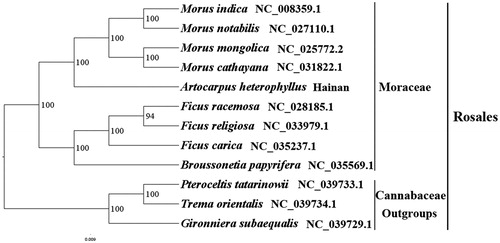Abstract
Artocarpus heterophyllus is an evergreen tree with 10–20 m height. It is distributed in tropical low-altitude areas, and is a tropical fruit with great economic value. Here, we report and characterize the complete plastome of A. heterophyllus in an effort to provide genomic resources useful for promoting its systematics research. The plastome of A. heterophyllus is found to possess a total length 160,389 bp with the typical quadripartite structure of angiosperms, contains two Inverted Repeats (IRs) of 25,708 bp, a large single-copy (LSC) region of 89,077 bp, and a small single-copy (SSC) region of 19,896 bp. The plastome contains 112 genes, consisting of 78 unique protein-coding genes, 30 unique tRNA genes, and 4 unique rRNA genes. The overall A/T content in the plastome of A. heterophyllus is 63.90%. The phylogenetic analysis indicated that A. heterophyllus is close to Morus cathayana within Moraceae in this study. The complete plastome sequence of A. heterophyllus will provide a useful resource for the conservation genetics of this species as well as for the phylogenetic studies of Moraceae.
Artocarpus heterophyllus Lam. (Moraceae, Rosales) grows as an evergreen tree that has a relatively short trunk with a dense treetop. It easily reaches the height of 10–20 m and trunk diameter of 30–80 cm. It is distributed in tropical low-altitude areas. It is possibly a native to the Western Ghats Mountains of India (Zhou and Gilbert Citation2003). It is a tropical fruit with great economic value.
Consequently, the genetic and genomic information is urgently needed to promote its systematics research and the development of conservation value of A. heterophyllus. Here, we report and characterize the complete plastome of A. heterophyllus (GenBank accession number: MK303549, this study). This is the first report of a complete plastome for A. heterophyllus.
In this study, A. heterophyllus was sampled from the campus of Hainan Universuty in Hainan Province of China (110.33°E, 20.06°N). A voucher specimen (Wang et al., B250) was deposited in the Herbarium of the Institute of Tropical Agriculture and 52 Forestry (HUTB), Hainan University, Haikou, China.
The experiment procedure is as reported in Zhu et al. (Citation2018). Around 6 Gb clean data were assembled by using Novoplasty v2.7.2 (Dierckxsens et al. Citation2016). The plastome was annotated using Geneious R8.0.2 (Biomatters Ltd., Auckland, New Zealand) against the plastome of Morus cathayana (NC_031822.1) (Kong and Yang Citation2017). The annotation was corrected with DOGMA (Wyman et al. Citation2004). The plastome of A. heterophyllus is found to possess a total length 160,389 bp with the typical quadripartite structure of angiosperms, contains two Inverted Repeats (IRs) of 25,708 bp, a large single-copy (LSC) region of 89,077 bp, and a small single-copy (SSC) region of 19,896 bp. The plastome contains 112 genes, consisting of 78 unique protein-coding genes, 30 unique tRNA genes, and 4 unique rRNA genes. Among these genes, one is a pseudogene [ndhD (translation from 126413 bp to 127906 bp)].
The overall A/T content in the plastome of A. heterophyllus is 63.90%, which the corresponding value of the LSC, SSC and IR region were 66.30%, 70.80% and 57.20%, respectively. We used RAxML (Stamatakis Citation2006) with 1000 bootstraps under the GTRGAMMAI substitution model to reconstruct a maximum likelihood (ML) phylogeny of eight published complete plastomes of Moraceae, using three species of Cannabaceae as outgroups. The phylogenetic analysis indicated that A. heterophyllus is close to Morus cathayana within Moraceae in this study (). Most nodes in the plastome ML tree were strongly supported. The complete plastome sequence of A. heterophyllus will provide a useful resource for the conservation genetics of this species as well as for the phylogenetic studies of Moraceae.
Figure 1. The best ML phylogeny recovered from 12 complete plastome sequences by RAxML. Accession numbers: Artocarpus heterophyllus (GenBank Accession number: MK303549, this study), Morus indica NC_008359.1, Morus notabilis NC_027110.1, Morus mongolica NC_025772.2, Morus cathayana NC_031822.1, Ficus racemosa NC_028185.1, Ficus religiosa NC_033979.1, Ficus carica NC_035237.1, Broussonetia papyrifera NC_035569.1, Outgroups: Pteroceltis tatarinowii NC_039733.1, Trema orientalis NC_039734.1, Gironniera subaequalis NC_039729.1.

Disclosure statement
No potential conflict of interest was reported by the authors.
Additional information
Funding
References
- Dierckxsens N, Mardulyn P, Smits G. 2016. Novoplasty: de novo assembly of organelle genomes from whole genome data. Nucleic Acids Res. 45:e18.
- Kong WQ, Yang JH. 2017. The complete chloroplast genome sequence ofmorus cathayanaandmorus multicaulis, and comparative analysis within genusmorusl. PeerJ. 5:e3037.
- Stamatakis A. 2006. RAxML-VI-HPC: maximum likelihood-based phylogenetic analyses with thousands of taxa and mixed models. Bioinformatics. 22:2688–2690.
- Wyman SK, Jansen RK, Boore JL. 2004. Automatic annotation of organellar genomes with DOGMA. Bioinformatics. 20:3252–3255.
- Zhou Z, Gilbert MG. 2003. Flora of China. Beijing: Science Press.
- Zhu ZX, Mu WX, Wang JH, Zhang JR, Zhao KK, CR, Friedman, Wang H-F. 2018. Complete plastome sequence of Dracaena cambodiana (Asparagaceae): a species considered “Vulnerable” in Southeast Asia. Mitochondrial DNA Part B. 3:620–621.
